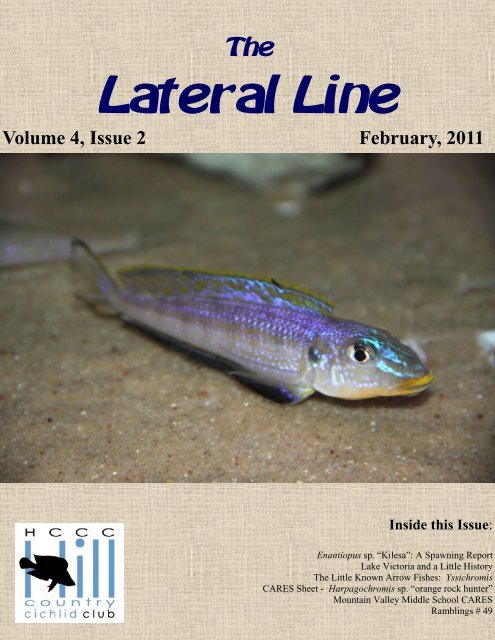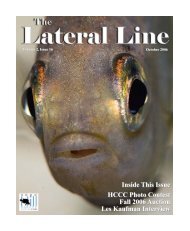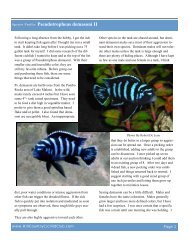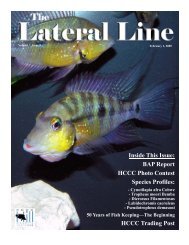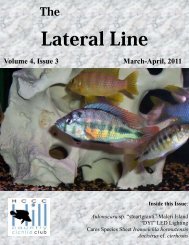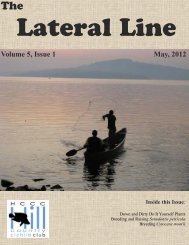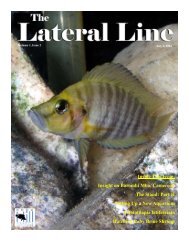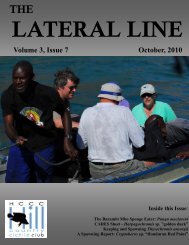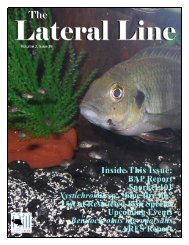February 2011 Lateral Line - Hill Country Cichlid Club
February 2011 Lateral Line - Hill Country Cichlid Club
February 2011 Lateral Line - Hill Country Cichlid Club
Create successful ePaper yourself
Turn your PDF publications into a flip-book with our unique Google optimized e-Paper software.
1<br />
The<br />
<strong>Lateral</strong> <strong>Line</strong><br />
Volume 4, Issue 2 <strong>February</strong>, <strong>2011</strong><br />
Inside this Issue:<br />
Enantiopus sp. “Kilesa”: A Spawning Report<br />
Lake Victoria and a Little History<br />
The Little Known Arrow Fishes: Yssichromis<br />
CARES Sheet - Harpagochromis sp. “orange rock hunter”<br />
Mountain Valley Middle School CARES<br />
Ramblings # 49
2<br />
The HCCC is a proud member of<br />
the Federation of Texas<br />
Aquarium Societies.<br />
The HCCC is a proud member of<br />
the Federation<br />
of American Aquarium<br />
Societies.<br />
Contents:<br />
Enantiopus sp. “Kilesa”: A Spawning Report 4<br />
- Benjamin L. Smith<br />
Lake Victoria and a Little History 7<br />
- Kory Watkins<br />
The Little Known Arrow Fishes: Yssichromis 12<br />
- Greg Steeves<br />
CARES Sheet - Harpagochromis sp. “orange rock hunter” 20<br />
Mountain Valley Middle School CARES 23<br />
Ramblings #49 - Nick Andreola 25<br />
Cover: Enantiopus sp. “Kilesa” Photo by Benjamin L. Smith<br />
Our week of winter has come and gone. It<br />
was crazy to see everyone’s reaction to a<br />
little snow but even I have to admit, I did<br />
enjoy the weather (well, the day off work<br />
anyways). Before you know it , things will<br />
be blistering hot again and we’ll long for a<br />
nice cool day as we are experiencing now.<br />
excited as I’ve ever been about any event<br />
I’ve ever attended. The speaker lineup is<br />
incredible and the people attending will be<br />
from all over the continent. This is the biggest<br />
undertaking our little club has ever<br />
committed to so be sure to volunteer to<br />
make this everything that it can be.<br />
As we gear up for some big events, the club<br />
has been abuzz with activity. For the first<br />
time in more than a year we return to Rare<br />
Dave’s shop for the <strong>February</strong> meeting. I’ve<br />
got together a little slide show on our adventures<br />
on the Rio Comal. It should be a lot of<br />
fun. The big spring auction is March 19th in<br />
Shertz. This should be one of the largest<br />
we’ve ever had. I’m really looking forward<br />
to both the auction and seeing everyone once<br />
again. In April we have the 2nd annual<br />
<strong>Cichlid</strong> Exposition at Amazonia in Austin.<br />
So far Dave has agreed to present and we<br />
still have two slots left to fill. If you would<br />
like to give speaking a try, let me know.<br />
The big news, of course, is our hosting of<br />
FOTAS CARES in November. This is as<br />
As for this issue of the Later <strong>Line</strong>, I was<br />
pleasantly surprised at the submission of articles.<br />
We’ve got a good issue with rich<br />
content. Benjamin, our resident Tanganyikan<br />
guru has written a wonderful article on<br />
his breeding account of Enantiopus sp.<br />
“Kilesa”. I have to admit, seeing this fish<br />
again has really perked my interest in these<br />
sand dwelling rheophilics.<br />
For you Lake Victoria enthusiasts, Kory has<br />
written a summary of the history of the great<br />
lake. Keeping with his lead, I submit a review<br />
of some of my favorite haplochromines<br />
from the genus Yssichromis. To top it all<br />
off is a report on the great things happening<br />
with MVMS CARES. Until next month…..
3<br />
HCCC Leadership Group<br />
Robert De Leon<br />
Dave Hansen<br />
JB Edmundson<br />
Diane Tennison<br />
Dan Schacht<br />
Evan Bowers<br />
Greg Steeves<br />
HCCC Webmaster<br />
Robert DeLeon<br />
HCCC Database Guru<br />
Evan Bowers<br />
HCCC Treasurer<br />
Dave Hansen<br />
HCCC Membership<br />
Diane Tennison<br />
HCCC Librarian<br />
Takeru Garcia (Austin)<br />
Walter Wooton (San Antonio)<br />
HCCC <strong>Lateral</strong> <strong>Line</strong> Editor<br />
Greg Steeves<br />
HCCC BAP Chairman<br />
Dan Schacht<br />
HCCC CARES Chairman<br />
Troy Veltrop<br />
Box Exchange Committee<br />
Dave Schumacher<br />
Greg Steeves<br />
Marc Garcia<br />
HCCC CARES/International<br />
CARES Committee<br />
Claudia Dickinson<br />
Dave Hansen<br />
Barbara Wooton<br />
Troy Veltrop<br />
Greg Steeves<br />
HCCC Honorary Life Members<br />
Spencer Jack 2004<br />
Robert De Leon 2006<br />
Anton Lamboj 2007<br />
Dave Hansen 2007<br />
The HCCC Would like to thank the following<br />
club supporters. Without you, we<br />
wouldn’t be what we are!<br />
Omega Sea<br />
Aquatek<br />
Lisa’s Lair Bookstore<br />
Dave’s Rare Aquarium Fish<br />
<strong>Cichlid</strong> Press<br />
San Francisco Bay Brand<br />
Zoomed<br />
Central Aquatics<br />
Petfrontier<br />
Leslies Pool Supply<br />
Darby’s Tropical Fish<br />
Fish Hobby Supply<br />
USA Fish Box<br />
Amazonia International<br />
<strong>Cichlid</strong> News<br />
Ginger Products<br />
Aquadome<br />
Pet Barn
4<br />
Enantiopus sp. Kilesa: A Spawning Report<br />
-Benjamin L. Smith<br />
Two male Enantiopus sp. “Kilesa” in a territorial display in the authors aquarium.<br />
Enantiopus sp. “Kilesa” is an absolutely<br />
beautiful fish from the waters of Lake Tanganyika.<br />
It is a sand sifter that builds very<br />
interesting nests which the males guard with<br />
great zeal, but little true aggression. The<br />
males swim in partial circles letting the sun<br />
reflect off of their colorful sides as the females<br />
swim by in schools searching for the<br />
most attractive mate.<br />
These fish come from the western shore of<br />
the lake between the cities of Kalemie and<br />
Kavala, Zaire 1 which is only a 50 Km stretch<br />
of its 1828 Km shoreline. The water is very<br />
hard and alkaline and temperatures range<br />
from 77-79 F 3 .<br />
Enantiopus sp. “Kilesa” is cigar shaped and<br />
attains a total length of 6 inches. As juveniles,<br />
they are silver in color. As adults, the<br />
females remain silver, whereas the males<br />
attain their characteristic yellow lips as well<br />
as iridescent green on their snout and iridescent<br />
blue down their sides. They have black<br />
in their pectoral and anal fins and yellow<br />
and blue spangling in their dorsal fin.<br />
In nature, the males construct nests that consist<br />
of a shallow depression in the sand with<br />
small mounds or turrets of sand lining the<br />
edges. He will build a number of nests in<br />
his territory but when a female comes to<br />
spawn, they will only utilize one of his<br />
nests 2 . In the aquarium, my fish were not<br />
able to construct the full 2 foot diameter<br />
nest. Rather, they placed their small mounds<br />
on the edge of the glass along the outer perimeter<br />
of the nest but also constructed a<br />
smaller, inner circle of mounds approximately<br />
6-8 inches in diameter. I had two
5<br />
The slender female Enantiopus sp. “Kilesa”.<br />
males and two females and only one male<br />
maintained a nest in the 4 foot long 75 gallon<br />
aquarium. For tankmates, I used Cyprichromis<br />
leptosoma “Jumbo”. Both females<br />
spawned at the same time and the<br />
clutch size was 13 for one and 15 for the<br />
other. Of note, if I do a water change while<br />
the female is still holding eggs, she will spit.<br />
I encountered the same problem with Enantiopus<br />
melanogenys.<br />
My four fish were obtained from Dave’s<br />
Rare Aquarium Fish and were large enough<br />
to note the color in the males at 2.5-3 inches<br />
of length. The water in my tank mimics that<br />
of Lake Tanganyika, in that it is hard and<br />
alkaline. The temperature was around 73 F.<br />
Water changes of 50% were done once<br />
every four weeks. Filtration consisted of<br />
two hang-on-back filters rated for 60 gallons<br />
each. The lights were on a timer to be kept<br />
on for 12 hours each day. The tank was located<br />
in a waiting room and the fish were<br />
very timid and rarely showed their color.<br />
Décor consisted of a large piece of “holey”<br />
rock in the center with a smaller piece in one<br />
corner to provide the females a place to hide<br />
when they were not interested in spawning.<br />
The substrate was Quickcrete Play Sand.<br />
The parents were fed flake and the fry were<br />
started on Hikari First Bites and then moved<br />
to crushed flake.<br />
This is a fairly delicate fish that is sensitive<br />
to water quality. It is also skittish and will<br />
attempt to jump if scared, so a nice lid for<br />
the aquarium is a must. The fish is also on<br />
the pricey side and so I would not recommend<br />
this fish for the beginner, though I<br />
would not say you need to be an expert.<br />
Bibliography<br />
Konings, Ad. Back to Nature: Guide to<br />
Tanganyika <strong>Cichlid</strong>s. 2 nd Ed. <strong>Cichlid</strong><br />
Press, 2005.<br />
Konings, Ad. Tanganyika <strong>Cichlid</strong>s in their<br />
natural habitat. <strong>Cichlid</strong> Press, 1998.<br />
<strong>Cichlid</strong> Forum http://www.cichlidforum.com/profiles/species.php?<br />
id=1961
7<br />
Lake Victoria and a Little History<br />
- Kory Watkins<br />
A boat floats across the calm waters of Lake Victoria. Photo by Lawrence Kent.<br />
Lake Victoria is my favorite of the three<br />
main <strong>Cichlid</strong> lakes in Africa. It is very<br />
unique with varied speciation and a history<br />
that is unbelievable! I promise that after you<br />
read a little about this wonderful basin you<br />
will be inspired to get yourself some Lake<br />
Victoria cichlid species and join with others<br />
who take conservation seriously.<br />
Lake Victoria is very young if you compare<br />
it to other large lakes on this planet. Core<br />
samples taken from the bottom of the lake<br />
suggest that it is around 13,000 years old. If<br />
this is the case then Victorian species have<br />
evolved in a very short period of time. If you<br />
have ever kept a breeding group of cichlids<br />
from this area you would know this. Most<br />
are very prolific and adaptable in a wide variety<br />
of settings.<br />
Lake Victoria is 26,600 square miles in size,<br />
making it, in area, the continent's largest
8<br />
lake, the largest tropical lake in the world,<br />
and the second fresh water lake in the world<br />
in terms of surface area. Being relatively<br />
shallow for its size, with a maximum depth<br />
of 276 feet and a mean depth of 131 feet,<br />
Lake Victoria ranks as the seventh largest<br />
freshwater lake by volume, containing 2.2<br />
million acre-feet of water.<br />
Lake Victoria receives most of its water<br />
from direct precipitation (rain). The largest<br />
stream flowing into this lake is the Kagera<br />
River, the mouth of which lies on the lake's<br />
western shore. Lake Victoria lies within an<br />
elevated plateau in the western part of Africa's<br />
Great Rift Valley and is subject to territorial<br />
administration by Tanzania, Uganda<br />
and Kenya.<br />
Lake Victoria has a shoreline of 2,138 miles,<br />
and has more than 3,000 islands. These include<br />
the Ssese Islands in Uganda, a large<br />
group of islands in the northwest of the lake<br />
that are becoming a popular destination for<br />
tourists. Today, Lake Victoria in East Africa<br />
is one of the most populous regions in the<br />
world. The lake provides food, transport,<br />
and electricity to more than 30 million people.<br />
Before the 1950’s, Lake Victoria's ecology<br />
was outstanding with an incredible array of<br />
biodiversity. It was inhabited by over 500<br />
species of fish, 90% of which were cichlids,<br />
all but two haplochromine species; plenty of<br />
natural action largely untouched with so<br />
much diverse life.<br />
Exert from TED case Study 338, Lake Victoria:<br />
Fishing pressure on the lake began to intensify<br />
in the early 1900's when the British<br />
introduced flax gill nets, which soon<br />
replaced the local villagers' papyrus nets<br />
and fish traps. With over fishing, catch<br />
sizes began to drop; fishermen turned to<br />
nets with ever smaller mesh sizes and thus<br />
decimated both the breeding adults and<br />
young of many native species. By the<br />
1950s the ngege (Oreochromis esculentus)<br />
The ngege, Oreochromis esculentus.<br />
was commercially extinct and the labeo<br />
(Labeo victorianus) was not far behind. To<br />
compensate, British officials decided to<br />
stock the lake with new fish. The first<br />
nonnative species of tilapia (<strong>Cichlid</strong>ae),<br />
that prospered was the Nile tilapia, Oreochromis<br />
niloticus, which feeds on the minute<br />
forms of plant and animal life called<br />
plankton, introduced in the early 1950s.<br />
In 1955 the Nile Perch Lates nicloticus<br />
(Centropomidae) was introduced into<br />
Lake Kyoga, and when a few years later it<br />
was found in Lake Victoria, steps were<br />
taken to ensure its establishment there.<br />
Despite such changes, the haplochromines<br />
appeared to be thriving in the 1950s. In<br />
act, they appeared so robust that some<br />
colonial administrators favored introducing<br />
a big predator like the Nile perch to<br />
eat what they considered bony little<br />
"trash" fish and "convert the haplochromine<br />
biomass" into something<br />
more able for the restaurant table. Ecologists,<br />
fearing the worst for local species,<br />
strongly opposed the predator. But in<br />
1954 illicit Nile perch began appearing in
9<br />
Lates niloticus, the infamous Nile Perch. Photo by Lawrence Kent.<br />
commercial catches anyway. Since the<br />
dirty deed was done, officials continued to<br />
stock the lake with perch in the early<br />
1960s. Speculation is that the perch were<br />
first slipped into the lake by colonial<br />
sportsmen, just as homesick British anglers<br />
put trout into highland streams<br />
throughout eastern and southern Africa.<br />
Still, for the next decade or so, the alien<br />
perch population remained small. A<br />
United Nations sponsored survey completed<br />
in 1971 found that haplochromines<br />
still made up 80 percent of the lake's fish<br />
biomass.<br />
Then came what Pereti Basasibwaki, a<br />
Fisheries Research Institute biologist,<br />
calls the dark period, the years between<br />
1974 and 1979 when Idi Amin cut off access<br />
to the lake from Uganda. Until 1978,<br />
Nile Perch remained a very small proportion<br />
of the commercial catch, less than 5<br />
percent. It wasn't until 1979 that the Kenyan<br />
government took over an idle Kisumu<br />
facility and work resumed under ICM-<br />
FRI's auspices. Pilot surveys suggested<br />
the lake's fish biomass was unchanged: it<br />
still appeared to consist of 80 percent haplochromines<br />
and less than 2 percent Nile<br />
perch. But in 1980 an abrupt change<br />
showed up in Kenyan waters, and within<br />
two years it appeared in Ugandan and<br />
Tanzanian waters too. Nile perch suddenly<br />
jumped to 80 percent of the biomass,<br />
and haplochromines dropped to 1<br />
percent. The ngege, already rare, virtually<br />
disappeared. Clearly something had<br />
been building during the unmonitored
10<br />
1970’s to cause such a massive explosion<br />
of perch. As for the Haplochromines, the<br />
leading theory is that they simply provided<br />
the predator's fodder. However,<br />
when Nile Perch were introduced into<br />
Lake Victoria some 30 years ago to improve<br />
game fishing, few would even have<br />
guessed that it might cause the elimination<br />
of whole species and the degradation<br />
of the area surrounding the lake. Then in<br />
1978 a very rapid expansion of the proportion<br />
accounted for by Nile Perch took<br />
place, with the result that by 1990 the<br />
commercial catch had a totally different<br />
composition, dominated by Nile Perch<br />
(almost 60 percent) and Omena (most of<br />
the remaining 40 percent). The haplochromines,<br />
and the mixture of other fish<br />
had virtually vanished from the commercial<br />
catch.<br />
Wikipedia: http://en.wikipedia.org/wiki/<br />
Lake_Victoria<br />
Large Lakes Observatory, University of<br />
Minnesota: http://www.d.umn.edu/llo/<br />
TED Case Studies: Lake Victoria: http://<br />
www1.american.edu/TED/victoria.HTM<br />
Today people like Greg Steeves, Nick Andreola,<br />
Troy Veltrop, many other hobbyists<br />
and myself are pushing to keep these rare<br />
species going. Lake Victoria today is a<br />
muddy, murky, polluted lake and it is also<br />
overstocked with predator fish that kill anything<br />
in sight.<br />
After reading this I would hope that you<br />
have learned a little history about the lake<br />
and are interested in keeping a Victorian<br />
species of some sort. We need hobbyist to<br />
step up and offer a spot for a few of these<br />
species in there homes. Breed them and<br />
spread the love! Conservation is the key to<br />
their prolonged existence. So again please<br />
open up a tank for these little critters you<br />
won't regret it!<br />
Ugandan children with a basket full of<br />
haplochromines. Photo by<br />
Lawrence Kent.<br />
References:<br />
Steeves, Greg. Lake Victoria: A Brief History.“<br />
http://hillcountrycichlidclub.com/ articles/Lake%20Victoria%20History.pdf”
12<br />
The Little Known Arrow-fish; Yssichromis<br />
- Greg Steeves<br />
Yssichromis piceatus in the authors aquarium.<br />
The arrow shaped cichlids of the Yssichromis<br />
genus were once a group of open<br />
water schooling fish that roamed the top<br />
strata of their native waters. After the Nile<br />
perch (Lates niloticus) upsurge in the<br />
1980’s, most species were thought to have<br />
expired. Later collections not only found<br />
these species once again but in number<br />
thought to be greater than before the massive<br />
ecological changes occurred in Lake Victoria.<br />
As an ever adaptable haplochromine,<br />
some Yssichromis survived implanted in<br />
large cyprinid schools while others took to<br />
rocky areas for cover. Debate is still ongoing<br />
as to whether or not these differing<br />
niches have caused anatomical changes in<br />
these fish. All Yssichromis make idea candidates<br />
for the aquarium although only a few<br />
representatives have ever been introduced<br />
into the aquarium hobby.<br />
Yssichromis heusinkveldi Witte & Witte-<br />
Maas, 1987<br />
Together with Yssichromis pyrrhocephalus,<br />
the similar Yssichromis heusinkveldi prior to<br />
1980 made up the bulk of trawls in Lake<br />
Victoria. Unfortunately, in the years following,<br />
Y. heusinkveldi became increasingly<br />
rare while today we know that Y. pyrrhocephalus<br />
is becoming more abundant. The<br />
former species was obviously more readily<br />
adaptable to changing surroundings while Y.<br />
heusinkveldi could not cope with predators<br />
or water conditions. At best, this fish is considered<br />
critically endangered in Lake Victo-
13<br />
A young Yssichromis piceatus male in the aquarium.<br />
ria. I am not aware of this beautiful little<br />
animal ever being maintained in captivity.<br />
Yssichromis laprogramma Greenwood &<br />
Gee, 1969<br />
Found in the northern portion of Lake Victoria,<br />
Yssichromis laprogramma was discovered<br />
near Nsadzi Island in Uganda.<br />
“Laprogramma” is in reference to the thick<br />
mid lateral stripe that dissects the flanks.<br />
This is another of the small schooling open<br />
water zooplankton eaters reaching 8.5cm. It<br />
appears to be just as abundant in its native<br />
waters now as it was before the Nile perch<br />
deluge. It is a shame that it has not yet entered<br />
the aquatic hobby as it would, in all<br />
probability, make for an ideal resident.<br />
Yssichromis pappenheimi Boulenger, 1914<br />
Named for the German biologist Artur Pappenheim<br />
(1870-1916) Yssichromis pappenheimi<br />
is native to Lakes George and Edward<br />
in the left arm of Africa’s Great Rift. Despite<br />
over-fishing in both waterways, Y. pappenheimi<br />
still appears frequently in native<br />
catches.<br />
This is a very small sardine-like cichlid at<br />
just over 6cm. Other than a slight darker<br />
coloration with adult males, both sexes are<br />
essentially silver fish with uncolored fins. It<br />
is fascinating to speculate how this Yssichromis<br />
and representatives of this genus<br />
from Lake Victoria have got to be where<br />
they are today and how they are related. It is<br />
unknown if this is a case of parallel evolution<br />
or geological seeding. Either way, this<br />
is yet another beautiful fish that has not<br />
made it to the aquarium trade.
14<br />
Two Yssichromis piceatus males displaying in the aquarium.<br />
Yssichromis piceatus Greenwood & Gee,<br />
1969<br />
The beautiful little cichlid Yssichromis<br />
piceatus is aptly named as the Latin root<br />
(piceatus) means “smeared with pitch” referring<br />
to the black body coloration of the adult<br />
male. Originally found near Jinja, Uganda<br />
(Napoleon Gulf opposite the Jinja prison) Y.<br />
piceatus is known to have had a wide distribution<br />
throughout Lake Victoria.<br />
It is a rather small fish growing to 9cm with<br />
little dimorphism between the sexes. The<br />
head has a straight incline and is arrow<br />
shaped (as is typical of Yssichromis; ‘yssos’-<br />
Greek for arrow). The body is slender and<br />
laterally compressed. The adult male has an<br />
all black body with a striking orange caudal<br />
fin. This same orange hue is found on the<br />
posterior of the dorsal and anal fins as well.<br />
The pelvic fins are black while the pectorals<br />
are clear. The females are dull silver with a<br />
mid lateral horizontal bar splitting the<br />
flanks. A black face bar lines through the<br />
eye and around the forehead. This same patterning<br />
can be seen on non-dominant males<br />
only with darker body coloration.<br />
The teeth are comprised of mainly unicuspid<br />
and tricuspid structure with the first tooth<br />
series being the only row completely exposed.<br />
Much as in Lipochromis, the back<br />
rows are not always uncovered above the<br />
gum. Natural food consists of small pupae<br />
(northern Lake Victoria samples while a diet<br />
of zooplankton was found in Mwanza populations.<br />
It is likely that Y. piceatus is an opportunistic<br />
feeder taking whatever minute<br />
fare is available at the time. Diet varies<br />
throughout the year.<br />
These fish make ideal aquarium residents.<br />
One must ensure not to house them with<br />
overly rambunctious tank mates. To show<br />
these fish at their best, they must not suffer<br />
any dominance issues with another species.<br />
Unless one is highly versed in hap-
15<br />
One can see why Greenwood called this fish piceatus meaning “smeared with pitch”.<br />
lochromine temperament, the best idea is to<br />
house Y. piceatus as the only cichlid species<br />
in an aquarium. Small Synodontis species as<br />
flavitaeniatus or alberti and some passive<br />
eels as Mastacembelus liberiensis work well<br />
for a little aquatic diversity. Y. piceatus is a<br />
good choice for one wanting to incorporate<br />
plants into aquascaping. These fish will<br />
generally not do any harm to all but the most<br />
tender of plants. The décor of the aquarium<br />
makes little difference to Y. piceatus. Plants<br />
or rockwork serve the same purpose and will<br />
allow these little haplochromines to feel<br />
comfortable. The deep adult male coloration<br />
will rarely develops in a bare tank.<br />
I use a substrate of fine sand as it has been<br />
reported that similar cichlid species will pick<br />
up smaller pebbles in the spawning sequence<br />
(possibly mistaken them for eggs) and<br />
through the course of mouth brooding, these<br />
will destroy the embryos. Spawning occurs<br />
indiscriminately; in no particular setting in<br />
the aquarium. We have seen most spawns<br />
occur in the early evening. The developing<br />
eggs are quite fragile. At around 18 days<br />
post spawning, the fully developed fry are<br />
free swimming and released from the mothers<br />
buccal cavity. Continued care by the female<br />
ensues for two weeks after which time<br />
it is best to separate the adult from her fry.<br />
Fry survival can be touchy as well. Feeding<br />
of commercially available cyclop cysts,<br />
newly hatched Artemia, and a mature sponge<br />
filter will increase survival counts.<br />
Unfortunately, as with some many other<br />
haplochromine cichlids, Y. piceatus is very<br />
rare in Lake Victoria. It has been in captive<br />
populations for over 20 years but has never<br />
been bred in sufficient numbers that would<br />
ensure its survival captive or otherwise.
16<br />
One of the most beautiful of all the zooplankton eaters, Yssichromis pyrrhocephalus.<br />
Yssichromis pyrrhocephalus Witte & Witte-<br />
Maas, 1987<br />
Another of the spectacular species of the<br />
open water zooplankton eaters to have escaped<br />
the Nile perch (Lates niloticus) onslaught<br />
by adjusting to another habitat, is<br />
Yssichromis pyrrhocephalus. Its range is<br />
recorded as the northern portion of Mwanza<br />
Gulf, Lake Victoria. The name is of Latin<br />
origin and translates to “fire head”. It was<br />
nearly driven to extinction in the 1990’s<br />
only to take residence amongst rocky habitats<br />
where it was easier to evade predation.<br />
Remarkably, the surviving individuals underwent<br />
apparent morphological changes<br />
including a decreased eye size, smaller more<br />
compact head and larger gills (Frans Witte et<br />
al., 2008). This serves as a prime example of<br />
how very adaptable haplochromine cichlids<br />
can be.<br />
This is another small cichlid with a maximum<br />
length of 8cm. Both females and quiescent<br />
males display a body coloration of<br />
metallic silver. All fins both paired and unpaired<br />
are largely translucent. The sexually<br />
active male sports an orange-red blaze with<br />
a prominent eye bar. The pelvic fins are<br />
black with orange dorsal, anal and caudal<br />
fins. One to three ocelli dot the back portion<br />
of the anal fin. The head is arrow shaped<br />
with a sleek tapered body akin to other Yssichromis<br />
species.<br />
These fish make ideal aquarium residents<br />
providing that the aquarium sports some sort<br />
of décor.
17<br />
Yssichromis sp. “argens” in the aquarium.<br />
Yssichromis fusiformis Greenwood & Gee,<br />
1969<br />
From the Buuvuma Channel west of Nienda<br />
and Vuga Islands in Uganda (Lake Victoria),<br />
Yssichromis fusiformis was taken from deep<br />
waters in open expanses. The body shape is<br />
of the “classic” arrowhead form common to<br />
this genus. Males grow to 11cm while females<br />
rarely reach 9cm. This is a very colorful<br />
fish with males having a purple coloration<br />
on the top portion of the body blending<br />
to a golden yellow color at the belly. The<br />
pelvic fins are black while the other fins are<br />
mostly colorless. Usually three orbited<br />
ocelli dot the anal fin. Females have a bluegrey<br />
back shading to sliver on the abdomen.<br />
Yssichromis sp. “argens”<br />
Originally catalogued from the Tanzanian<br />
waters of Lake Victoria, Yssichromis sp.<br />
“argens” is widely considered to be extinct<br />
in the wild. A small population is presently<br />
maintained in captivity within the AZA’s<br />
(American Zoos and Aquariums) Lake Victoria<br />
Species Survival Plan (LV-SSP). As<br />
far as I can ascertain, these fish are held in a<br />
single institution. One can only hope that<br />
the colony is still strong and can be filtered<br />
to dedicated hobbyists who have repeatedly<br />
proved their worth in dealing with propagation<br />
of endangered haplochromine species<br />
from Africa.<br />
This zooplankton feeder was a schooling<br />
open water species before massive ecological<br />
changes took place in the 1980’s. The<br />
maximum length of this species is 9cm with<br />
no noticeable difference between the sexes.<br />
There is considerable evidence suggesting<br />
that Y sp “argens may be synonymous with<br />
Yssichromis fusiformis. Captive care for Y.<br />
sp. “argens” should pose no difficulty as it<br />
has been reared successfully in captivity for<br />
over 20 years. One should employ a similar<br />
husbandry strategy as needed for other<br />
members of the genus.
18<br />
Yssichromis sp. “blue tipped” male in the aquarium. Photo by Dave Hansen.<br />
Yssichromis sp. “blue tipped”<br />
Yssichromis sp. “blue tipped” was discovered<br />
in 1992 by Yves Fermon and Olivier<br />
Berthelot off Rusinga Island Lake Victoria.<br />
This schooling species feeds upon zooplankton<br />
and will also take small insects in the<br />
wild. Maximum size is near 10cm for<br />
males, slightly smaller for females.<br />
Being an open water species, we house our<br />
group in a 65 gallon deep tank with a silica<br />
sand substrate. One side of this tank contains<br />
a small rock work structure. A few<br />
strands of artificial Vallisneria are situated<br />
in the middle of the tank. Filtration is provided<br />
by an Aquaclear® 300 hang on the<br />
back power filter. Weekly water changes of<br />
twenty gallons help maintain acceptable<br />
conditions. The Yssichromis sp. “blue<br />
tipped” are housed with a colony of Platytaeniodus<br />
sp. “red tail sheller” of similar<br />
size. This mixture works well as both species<br />
are distinct enough that hybridization is<br />
unlikely. The rock structure is used by the<br />
Platytaeniodus sp. “red tail sheller” as a territorial<br />
boundary but has little attraction to<br />
the Yssichromis sp. “blue tipped”. Neither<br />
species is overly aggressive with the other;<br />
squabbles are restricted to co specs. The<br />
Platyaeniodus sp. “red tail sheller” prefers to<br />
remain near the bottom while the Yssichromis<br />
sp. “blue tipped” are usually roaming<br />
the upper portion of the aquaria. There<br />
are occasional bluffing duels between the<br />
most dominant males of each species but<br />
these are no more than jetting forward in an<br />
attempt to back the other up. There is no<br />
physical contact or jaw locking that occurs.<br />
Yssichromis sp. “blue tipped” (“tipped<br />
blue”) as named by Fermon and Berthelot) is<br />
a very rare fish in the North American<br />
hobby. It is not held in the LV-SSP program<br />
so it is up to the hobbyist to ensure its survival.
19<br />
Schedule of Events<br />
<strong>February</strong> 19th 2:00 pm<br />
HCCC Meeting at Dave’s Rare Aquarium Fish In San Antonio TX.<br />
Greg Steeves speaking on the Comal River System.<br />
The club is not responsible for any incriminating photos of Members that<br />
might be shown during the presentation.<br />
March 13<br />
HCCC Spring Auction Shertz TX.<br />
April 9<br />
Amazonia’s <strong>Cichlid</strong> Symposium<br />
Amazonia International Austin TX.<br />
May<br />
HCCC Meeting<br />
Location and Speaker TBD<br />
June<br />
HCCC Auction Austin TX (tent.)<br />
July<br />
HCCC Meeting Capital of Texas Zoo<br />
Austin TX. Speaker Michael Hicks<br />
August<br />
HCCC Meeting TBD<br />
September<br />
HCCC Auction Shertz TX. (tent)<br />
October<br />
HCCC Meeting TBD<br />
November 4th-6th<br />
FOTAS CARES San Antonio TX.<br />
December<br />
HCCC Christmas Party
21<br />
Thank you to all out club supporters. We wouldn’t be who we are without you!<br />
Fish Hobby Supply<br />
a proud supporter of the HCCC<br />
10% off web orders<br />
Foods, Plants, Supplies<br />
www.africancichlids.net<br />
15% off total purchase<br />
excluding specials, package deals, and sale<br />
items<br />
12315 Wetmore Rd.<br />
San Antonio, TX 78247<br />
(210)653-8880<br />
www.petfrontier.com<br />
Leslie’s Pool Supply<br />
a proud supporter of the<br />
HCCC<br />
20% off Pool Supplies<br />
5-20% off selected items<br />
All Locations<br />
Telephone : (512) 442 - 1400<br />
Fax : (512) 442 - 4944<br />
Email : austinaquadome@aol.com<br />
Gabe's Fish and Exotic Pets<br />
a proud supporter of the HCCC<br />
15% off Livestock<br />
and most supplies<br />
5418 Glen Ridge<br />
San Antonio, TX 78229<br />
(210) 290-9376<br />
AquaTek Tropical Fish<br />
a proud supporter of the HCCC<br />
10% off Fish<br />
8023 Burnet Road<br />
Austin, TX 78757<br />
(512) 450-0182
22<br />
Amazonia<br />
International<br />
a proud supporter of the HCCC<br />
Member discounts:<br />
20% off Fish & Live Plants<br />
10% off Tanks, Stands, Eheims &<br />
Eclipses<br />
25% off Filters & Powerheads<br />
4631 Airport #116 Austin, TX<br />
(512) 451-0958<br />
http://grandapublishing.com/<br />
9722 Potranco Road<br />
San Antonio, Texas 78251<br />
210-520-9611
23<br />
Mountain Valley<br />
Middle School<br />
CARES<br />
In the summer of<br />
2009 middle school<br />
science teacher Debbie<br />
Bumgardner expressed interest in the<br />
<strong>Hill</strong> <strong>Country</strong> <strong>Cichlid</strong> <strong>Club</strong> CARES program.<br />
She had visualized creating a “hands on”<br />
approach to species conservation with her<br />
curriculum. After a few conversations and a<br />
little research the MVMS CARES project<br />
was born. Debbie had obtained a 75 gallon<br />
aquarium and once the word went out to<br />
HCCC members, additional equipment and<br />
livestock was graciously given to the program.<br />
Sparky, etc.), the kids were hooked. Each<br />
day they would diligently check their fish.<br />
As the first school year came to a close, one<br />
of the Xystichromis phytophagus was seen<br />
mouth brooding a clutch of eggs. The first<br />
successful spawn! The fry from this spawning<br />
was sent off to the Vienna Zoo. Some of<br />
this brood will go to the Capital of Texas<br />
Zoo to be displayed in the brand new cichlid<br />
exhibit and the remaining young joined their<br />
parent’s colony at the Mountain Valley Middle<br />
School for the 2010-<strong>2011</strong> school year.<br />
During the first year of MVMS CARES,<br />
Debbie was given the honor of being voted<br />
Teacher of the Year by her peers at Mountain<br />
Valley Middle School. In addition, the<br />
administration of both the school and district<br />
fully supported her involvement and the CA-<br />
RES effort.<br />
Teacher extrodinaire! Mrs. B.<br />
Debbie Bumgardner and Erin Olsen.<br />
Although the 2009-2010 school year was to<br />
be a learning experience with the main goal<br />
learning what would work and what would<br />
not, the students took an incredible interest<br />
in the fish. The livestock consisted of Xystichromis<br />
phytophagus, a CARES listed species<br />
from Lake Kanyaboli, Neochromis omnicaeruleus<br />
and Paralabidochromis chromogynos,<br />
both from Lake Victoria and Synodontis<br />
greshoffi from the Congo River. The<br />
students increased their knowledge base on<br />
these fish through studies and research and<br />
once the cichlid were given names (Bob,<br />
Riding on the successes of the first year of<br />
this CARES program, it was planned to expand<br />
the number of aquariums as well as the<br />
number of species being maintained. Additional<br />
equipment was donated though the<br />
generosity of HCCC members. Both parents<br />
and students came though with everything<br />
from needed items to décor such as rocks.<br />
Despite high expectations, the 2010-<strong>2011</strong><br />
students, although interested, seem to lack<br />
the full vigor shown by their predecessors.<br />
After a small setback with losing a few fish,
24<br />
and, starting out with young cichlids not<br />
showing the vibrant adult coloration, a decision<br />
was made to stock one aquarium with<br />
colorful cichlids. In this tank, young Pseudotropheus<br />
saulosi, Cynotilapia sp. “hara”<br />
and Pundamilia macrocephala are housed.<br />
The beautiful hues shown by these fish, even<br />
while juveniles, should interest the students<br />
and get them involved in what would be<br />
considered the next step, species maintenance<br />
of endangered cichlids. Additional<br />
aquariums will contain Lake Barombi Mbo<br />
cichlids from Cameroon. Myaka myaka.<br />
Pungu maclareni and additional Lake Victoria<br />
species will soon call Mountain Valley<br />
Middle School home. This year, the Federation<br />
of Texas Aquarium Societies provided a<br />
$250.00 award to MVMS CARES that will<br />
go towards the purchase of additional filtration<br />
and upgraded lighting.<br />
More updates will follow on what is certain<br />
to be a very successful CARES effort!<br />
MMS CARES would like to recognize the following<br />
organizations and individuals who, without<br />
their gracious support, this program would not be<br />
possible.<br />
Mike Kaaki<br />
Pat Mallinger<br />
Dave Hansen<br />
Henry Rockward Jr.<br />
<strong>Hill</strong> <strong>Country</strong> <strong>Cichlid</strong> <strong>Club</strong><br />
Troy Veltrop<br />
Benjamin Smith<br />
Fish Hobby Supply<br />
Paul V. Loiselle<br />
Dave’s Rare Aquarium Fish<br />
Robert Deleon<br />
Federation of Texas Aquarium Societies
25<br />
Ramble # 49<br />
- Nick Andreola<br />
Editor’s note<br />
I was very happy to get the first in what<br />
looks like a series of Ramblings by Nick. As<br />
the title suggests, this is an abstract, humorous<br />
but brilliant look at our hobby and ourselves.<br />
I hope you all enjoy this installment<br />
as much as I did and look forward to the<br />
second installment which I presume will be #<br />
59!<br />
This article was written for multiple purposes:<br />
I needed one for BAP, I’m a little<br />
bored with writing species articles and I<br />
know Greg is struggling mightily to fill each<br />
months LL with content. I hope it is a fun<br />
read and at least a little bit informative…but,<br />
and most of all, I hope it shows that you<br />
don’t necessarily have to write some dry<br />
scholarly textbook like article; sometimes,<br />
just sharing your own unique perspectives<br />
and observations can be worthwhile. So,<br />
start a Ramble of your own and let’s see<br />
where it takes us!<br />
Many of you with mammalian pets will understand<br />
this concept. Let’s get down with<br />
some imagi-math! Let’s say that the typical<br />
cichlid we keep has an average life span of 7<br />
years and the average human’s is 75. Applying<br />
our imagi-math, we could then say that<br />
every cichlid year is roughly equal to 10 human<br />
years….with me so far? Using the canine<br />
reciprocal factor of theoretic ratio continuity<br />
we will say that the extra 5 human<br />
years which don’t fit conveniently into our<br />
imagi-math go to the cichlids first year.<br />
Therefore at one human year (HY) our little<br />
cichlid is 15 cichlid years (CYs ) old…..at<br />
two HY; it is 25 CY etc…..<br />
Now, let’s do a ‘Bones’ or CSI-like age progression.<br />
Your attention to the enhanced<br />
graphics being displayed on the high-res<br />
screen in your mind, please. See the little fry<br />
grow and begin to take on adult appearance?<br />
At one HY our little wiggler has become a<br />
possibly sexually active teenager. Yes, it is<br />
biologically feasible (and in some parts of<br />
backwoods Arkansas; still permissible) to<br />
procreate with humans at this age! Many<br />
mouth brooder females will have several<br />
unsuccessful attempts before finally releasing<br />
their relatively small first batch of fry.<br />
Pair bonding fish may also go through several<br />
dry runs or failures before they get it<br />
right. This is to be expected; after all, how<br />
many human couples who have ‘spawned’ at<br />
this early age do you know that really had it<br />
all together?<br />
From one to five HYs (15 to 55 CYs) our<br />
teenager has moved into the prime of its life.<br />
Its colors brilliant, fins resplendent and<br />
slime coat….well…slimy! For both sexes,<br />
this age range may be their reproductive<br />
peak. For many cichlid types, just like for<br />
humans, somewhere towards the end of this<br />
period the females will become less and less<br />
active producing babies. I’m not sure if the<br />
lack of fishy plastic surgeons (and fish<br />
equivalent breast implant-like enhancements)<br />
make the females less attractive to<br />
the males or if the males grow into boring<br />
NFL-watching, beer swizzling couchpotatoes<br />
(and unattractive to the females) or<br />
if the females go through some kind of piscopause.<br />
I do know that if the male has an<br />
owner who has paid attention to the Larry<br />
King School of human reproduction, the introduction<br />
of young females will usually inspire<br />
the middle-aged cichlid male to continue<br />
to father offspring for many years into<br />
the future. Lending some credence to the<br />
piscopause concept; I have had very few<br />
Demi Moore-like older females. In fact the<br />
cichlid cougar is much more likely to kick a<br />
new young stud’s butt than to mate with<br />
him. During this ‘prime’ period, one could<br />
(and should) expect that both sexes will look
26<br />
their absolute best and represent their species<br />
as well as genetics and husbandry allows.<br />
Dominant males of territorial species<br />
are able to claim and to vigorously hold on<br />
to their chosen sites. Subdoms and females<br />
are fleet and agile; easily able to avoid unwanted<br />
attention from more aggressive tank<br />
mates. Any battle damage sustained heals<br />
quickly. This is the time that you’re most<br />
likely to get that award winning photograph<br />
of your show male displaying awesome colors<br />
with no nips or tears in his fins.<br />
As our former little wigglers move in the<br />
‘golden’ years and join the AARC (6+ HYs<br />
~65+CYs) many changes occur. Just like<br />
with their human owners, many of our cichlids<br />
become less active and begin to put on<br />
some additional ‘padding’. While the fish’s<br />
‘middle-aged spread’ may not manifest itself<br />
in a beer belly, it is not hard to see the extra<br />
bulk when comparing older specimens with<br />
‘prime’ ones. Just as the thick luxuriant<br />
mane of the male human thins, grays and<br />
possibly retreats, the stunning colors of the<br />
cichlid male slowly fade and/or are displayed<br />
less and less. For some species, Lake<br />
Victoria basin types I’ve kept for example,<br />
the male coloration actually changes from<br />
the intense reds of youth to a dark, almost<br />
black base color. If kept without any challengers,<br />
the aging male will still fulfill his<br />
previous responsibilities (albeit, at a much<br />
slower pace!). However, if housed with<br />
younger males of other species, the former<br />
tank boss may be forced to step down a<br />
notch or two in the pecking order. There will<br />
typically be some fin/scale damage done<br />
while this transition takes place. The recuperation<br />
from these battles will be longer<br />
with each passing year. In the worst cases<br />
I’ve seen in this situation the old male will<br />
take on very muted coloration, will claim no<br />
territory and will spend his days swimming<br />
with the groups of females. If housed with<br />
younger males of his own species, very often<br />
the older cichlid male will not relinquish<br />
his dominance until he is bruised and battered<br />
to the point he requires removal or he<br />
dies. (And Disney tried to make the ‘circle<br />
of life’ into a syrupy show song!)<br />
After 7+ HYs (75+ CYs), if the fish are<br />
given the opportunity to swim out their remaining<br />
months in your “Tranquil Acres”<br />
rest tank, you will notice a steady decline on<br />
their overall health. They may have to return<br />
to their caves for their dentures, so feeding<br />
time may be somewhat lengthened. Their<br />
driver’s licenses will have to be taken because<br />
the cataracts make the rocks so hazy<br />
and so easy to run into. Tranquil Acres may<br />
just have to become an obstacle free zone.<br />
This may be when the owner has to gutcheck<br />
their opinions on euthanization. I’ve<br />
decided that I have enough tank space to let<br />
nature take its course so my fish room has its<br />
fair share of geezer fish. But, that’s okay<br />
with me; I usually enjoy hanging out with<br />
them more than with some of the young<br />
punks with all that loud noise they call music…but<br />
that’s a different ramble. I hope<br />
you don’t feel badly for these old timers.<br />
Not long ago, I had a wonderful chat with<br />
one of my favorite retired breeder males on<br />
what turned out to be his last day. He told<br />
me: “Stop with the tears, you’re messing up<br />
my water chemistry! It has been a glorious<br />
life …. Room service meals delivered every<br />
day, maids and maintenance men in every<br />
week and on call 24/7 and, oh, the females<br />
I’ve shared my tank with!!!! Hubba-hubbading-ding!<br />
I had SIX lovely young ladies in<br />
my last harem---and that was my third<br />
harem! But the best of all….I‘ve fathered<br />
hundreds of children (who have moved all<br />
over the country) and I can only imagine<br />
how many grandchildren are out there!”<br />
So don’t feel sad when you lose one of<br />
your old timers. Be content that you’ve got<br />
to see the cycle from fry to geezer …and
27<br />
that your hard work, patience and dedication<br />
is what made it happen. Now its time to<br />
really get to know Junior…and who<br />
knows?...you might just find that you actually<br />
kinda like that new loud music!<br />
PS: please, refer to this Ramble (#49) when<br />
reading the upcoming Ramble (#50) about<br />
“Why doesn’t my fish look EXACTLY like<br />
the one in the photograph?”
28<br />
The <strong>Lateral</strong> <strong>Line</strong> is the official publication of the <strong>Hill</strong><br />
<strong>Country</strong> <strong>Cichlid</strong> <strong>Club</strong>. Reprinting permitted to non<br />
commercial organizations.


